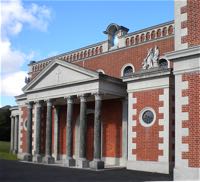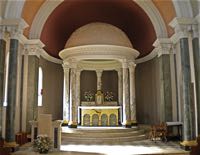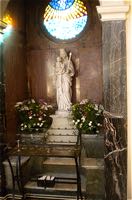
Blessed Sacrament, Heavitree
Researched and written by Julia Sharp
Page added 16th November 2015
During the 1920s the number of people attending Sacred Heart Catholic Church in South Street Exeter increased. Therefore in 1930 it was decided to form a new parish called Blessed Sacrament in Heavitree.
Heavitree House and grounds were purchased from Mr. Woodgates. The House was Georgian in style and it was used as a chapel and presbytery as soon as purchased and continued as such after the new church was built. The grounds were big enough to allow the Church space, now used by parishioners for car parking, not given to similar organisations.
The foundation stone
On 7 June 1931, in the rain, Right Rev. John Patrick Barrett Catholic Bishop of Plymouth laid the foundation stone, and in a cavity under the stone was placed a leaden casket with an inscription, coins and a copy of ‘The Universe’ inside. In view of the inclement weather the Sermon was ‘dispensed with’. However representatives from all over the county and beyond filed past the foundation stone placing offerings on it. The Bishop gave the Benediction at an improvised altar in another part of the garden. Nearly 40 adults and children attended the Episcopal visitation in the morning.
The Church took a year to build and cost £15000. Much of this was provided by the Robinson family in particular the two Misses Robinson who, in the 1930s paid for five new Churches, the first of which was Heavitree, followed by St. Peters Crownhill Plymouth; St. Paul St. Budeaux; Chelston in Torquay; and Bishopsteignton.
Consecration
On 28 May 1932 the Bishop returned to open the Church, He perambulated around the grounds of the Church before entering the church. He was supported by Clergy from as far afield as Calcutta and as near as Buckfast. The service was relayed to the crowd by means of an amplifier and tickets were needed to attend the Latin Mass the next day.
The Church is said to be based on the design of St. Paul Outside the Wall Basilica in Rome, and was built by Mr. E. B. Wheatley. Built of Red Brick with Portland Stone corners, window surrounds and roof parapet. The Portico Entrance has six green marble columns.
Inside, the sanctuary is distinguished by its great white arch which holds the Baldachino or canopy which is supported on seven columns of Italian Cippolino marble, with the altar in green onyx, and tabernacle in polished brass.
There is extensive use of marble saved from the demolition of Marley House on Woodbury Common, which adds to the setting for the Virgin and Child and the 14 stations of the cross.
Campanalia or Bell Tower
This was originally 90 ft. high, but suffered a glancing blow from one of the bombs dropped on Heavitree on 4 May 1942. This reduced the height to about 60 ft. It has not been restored in height but now houses a four-ton bell named Emmanuel, which is the third largest in South West England.
4 May 1942 The bomb that decapitated the Bell Tower completely destroyed the presbytery. Father Tyman had a remarkable escape, as something prompted him to go over to the church just before the bomb crashed into the presbytery. Other bombs destroyed the original stained glass windows in the church.
Saint Richard Reynolds Centre
When the presbytery was rebuilt there was added a flat over for the Priest and a Hall now named the Saint Richard Reynolds Centre. This is for Parish use and can be let for group activities, for outsiders.
Richard Reynolds was born in 1492 and was thought to have come from the Pinhoe area of Exeter. He was a Bridgettine Monk from Syon Abbey in Isleworth, supposedly the only English Monk well-versed in the three principal languages Latin, Greek and Hebrew. When Henry VIII married Anne Boleyn he demanded everyone acknowledge him as head of the Church. Richard refused, as did a few other Priests. He was imprisoned in the Tower mid April 1535 and executed by being hanged then drawing and quartering at Tyburn Tree on 4 May 1535. He was canonised as one of the forty Martyrs of England and Wales on 25 October 1970. There is a Martyrs Chapel in the Church dedicated to St. Richard Reynolds.
Bridgettine Order of Nuns and Monks - Syon Abbey The English branch of the Bridgettine Order was founded in 1415 to follow the discipline laid down by a Swedish holy woman, and recruited both men and women with an Abbess at the head. Although they had to go abroad after the reformation they returned to England as soon as the restrictions were lifted in the 19th century. Their final home was a converted Georgian stable block in South Brent in Devon. Once numbers dropped to three, they decided they must find homes for their vast library and other artefacts. In 2004 their remaining medieval manuscripts were loaned to Exeter University for safe keeping.
In June 2011 the Abbess and Sisters of Syon Abbey came to Blessed Sacrament with a gift of items relating to St. Richard Reynolds including a carved stone column head from pre-reformation Syon, vestments for the feast day and a painting depicting the martyrdom. It was thought that as this Church already had a plaque of the Saint who had an active part in the life of the Church, it was the most suitable resting place for these other relics. The Nuns moved to Catholic run premises in Plymouth, and put their premises on the market.
Sources: Items on the internet, Newspaper archives, Around the Churches of Exeter - Walter Jacobson, notes taken on visit
│ Top of Page │



